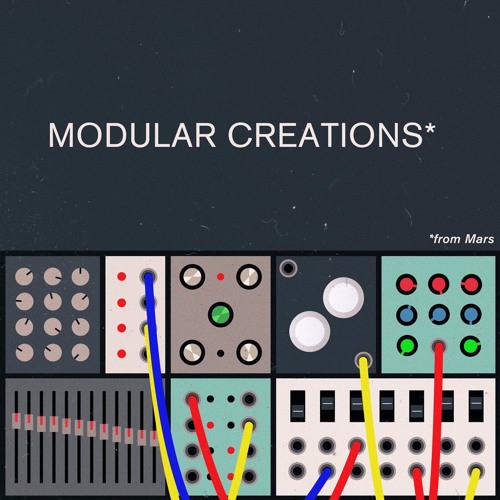Samples From Mars Modular Creations From Mars MULTIFORMAT
Bring the Chaos of the Modular World to Your DAW
A little over ten years ago, Doepfer, with the help of Kraftwerk, released several small synth components in the newly designed Eurorack format. Beginning with simple analog modules, the company paved the way for others to create their own designs, which naturally began to stray (in the best of ways) from the traditional modules. Today, the format is more popular than ever, with hundreds of Eurorack modules, ranging from simple VCOs to advanced DSP effects units.
Our Eurorack system is the culmination of collecting and piecing together these modules for the past ten years, and is a pretty good representation of where the modular world is at today. It’s filled with unique sequencers, wonky FX, and almost infinite modulation possibilities. On any given day you never know exactly what you’re going to get out of it, but you can be sure of one thing: whatever it is, it’ll be a unique modular creation that is impossible to achieve with any other type of gear.
The Recording Process / Capturing the Loops
Recording a modular system for people to use in their DAWs is a challenge, because the beauty of modular synthesis is not only found in the sounds, but in the continuously modulating characteristics of each patch. Whether this is the shifting of a sequencer’s timing, or modulating an effect’s internal digital processor with a slight CV signal (a modular trick that would actually blow up a modern computer’s processor), the beauty is all in the movement. Because of this, we thought the most authentic representation of our modular would be to record batches of long loops and drones (at 120 bpm), and edit them down, isolating each at their most useable moment in time.
This approach allowed us to capture the weird, little (and sometimes big) nuances that modulars produce. In one instance, we used the filter cutoff as a modulation source, and applied that signal simultaneously to the room size of a reverb and the pitch of a frequency shifter. Creating these types of interactions, you soon start to hear how cool the results of unlikely parameters sharing the same modulation signals are…kind of like how two people that have been at odds with each other can become best buds (think Bob Moog and Don Buchla…RIP)!
During the recording process, we patched many modules together, ultimately focusing our efforts on 7 primary sound sources: the Basimilus, Elements, Model15, STO, Teleharmonix, Tides, and VCO6, capturing the results through a variety of preamps (API, Neve, EMT, NonLinear) best suited for each sound. We synthesized all types of stuff: percussive synth syncopations, 8 bit basslines, wonky guitar sounds, mallets, sirens, falling jenga blocks and cracked out claves to name a few.
Ambient Drones and Raw Voltage
Besides rhythms and sequences, we also created super complex, long (sometimes over a minute) passes of evolving drones – using ultra slow sequencers to continually modulate the ambience. We created both waves of slow space/time traveling modulation and a bunch of raw voltage clips, which are wild, synthesized madness that have no time or key affiliations…think modular anarchy.
These are great for adding energy and atmosphere to tracks, or incorporating spontaneity into your live set. Very little external processing was used on the final recordings so you have the option of keeping your modular drones raw or headroom to apply further processing on your own.
The Instruments
While the loops are certainly the most authentic representation of our Eurorack, the instruments give you the greatest flexibility, since you can write your own bass, chords and melodies with these weird modular textures.
To create the instruments, we took the loops and drones and created one shots – capturing static moments of modulation. Next, we mapped them chromatically and created single cycle loops for infinite sustain, moving those loops around to dial in the texture for each patch. We then layered different transients and one-shots from various loops modules, applying further LFOs, filters and FX routing within each instrument.
Ableton Midi Racks
The Ableton midi racks are an excellent way to provide more flexibility when working with the modular loops. You get a drum rack, with each hit in a given loop assigned to each drum pad, and a corresponding midi clip will play back the loop. You can then start moving the midi notes around, copy, pasting and deleting, and further adjust the filter and amp settings with 8 macros, or on a per note basis. All this is to say you can come up with some very creative, realistic sounding modular sequences.
The End Result
Honestly it’s impossible to put everything that such an amazing Eurorack setup has to offer in one sample pack. BUT. This is an excellent head start into the the world of modulars…especially if you’re not quite ready to trade all of your money and time spent with loved ones in exchange for that sweet, addicting “Eurocrack.”
Contents:
- 140 Modular Loops Recorded at 120 BPM (24bit WAV, Apple Loops, REX2)
- 46 Ever-Modulating Ambient Drones (WAV)
- 35 Raw Voltage Blips, Bloops & Modular Anarchy (WAV)
- 24 Chromatic Instruments for Ableton, Kontakt, Logic & FL Studio
- 40 Ableton Loop Midi Racks
- 1.75 GB Total
Ready For:
- 24 bit WAV Compatible DAW or Sampler
- Ableton Live 9.7+ (Not Intro)
- Kontakt 5.6.5+ (Not Kontakt Player)
- Logic 9+
- FL Studio 20.8+
- 1.75 GB Free Space
Demo Preview:
- Share on Facebook


